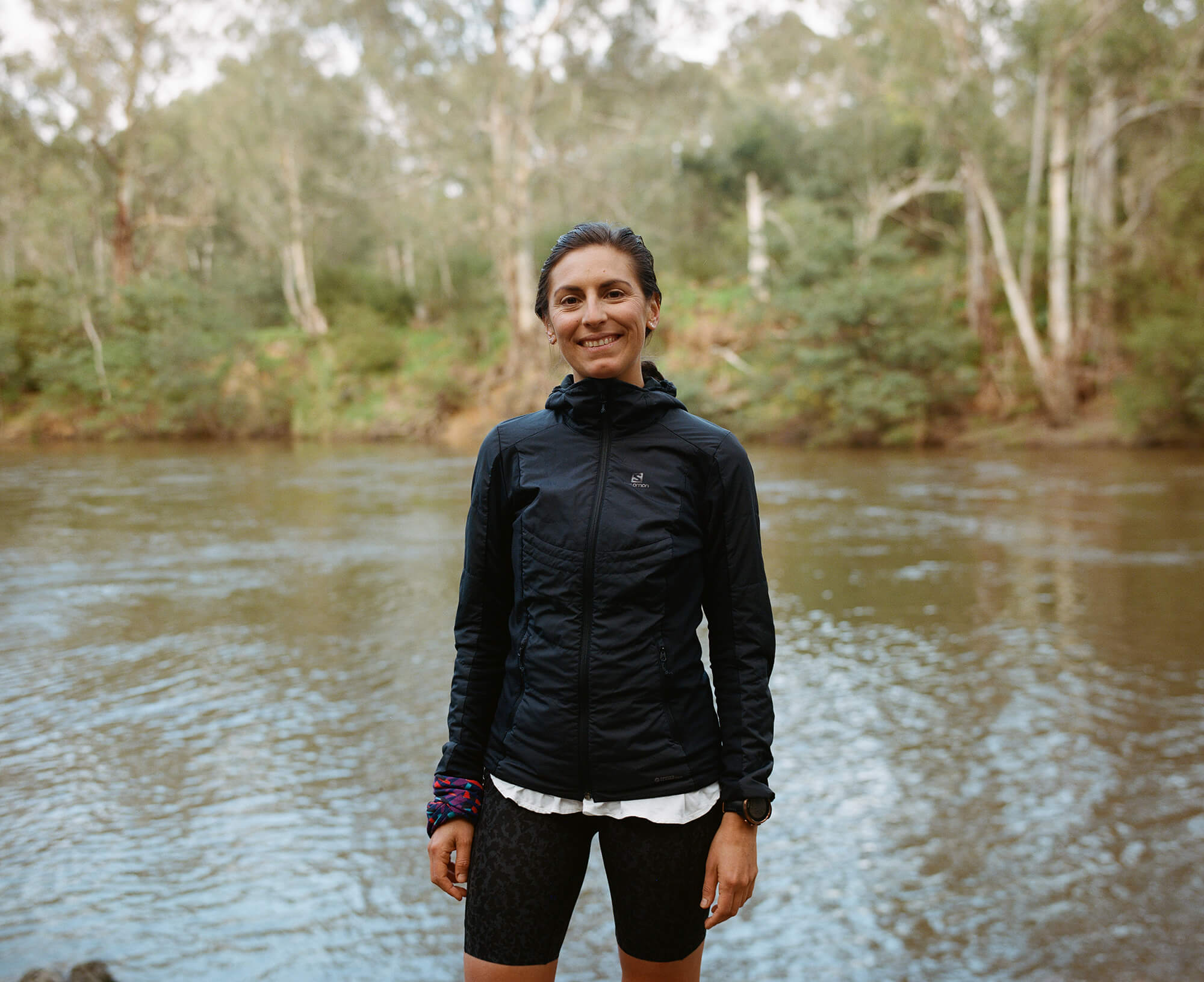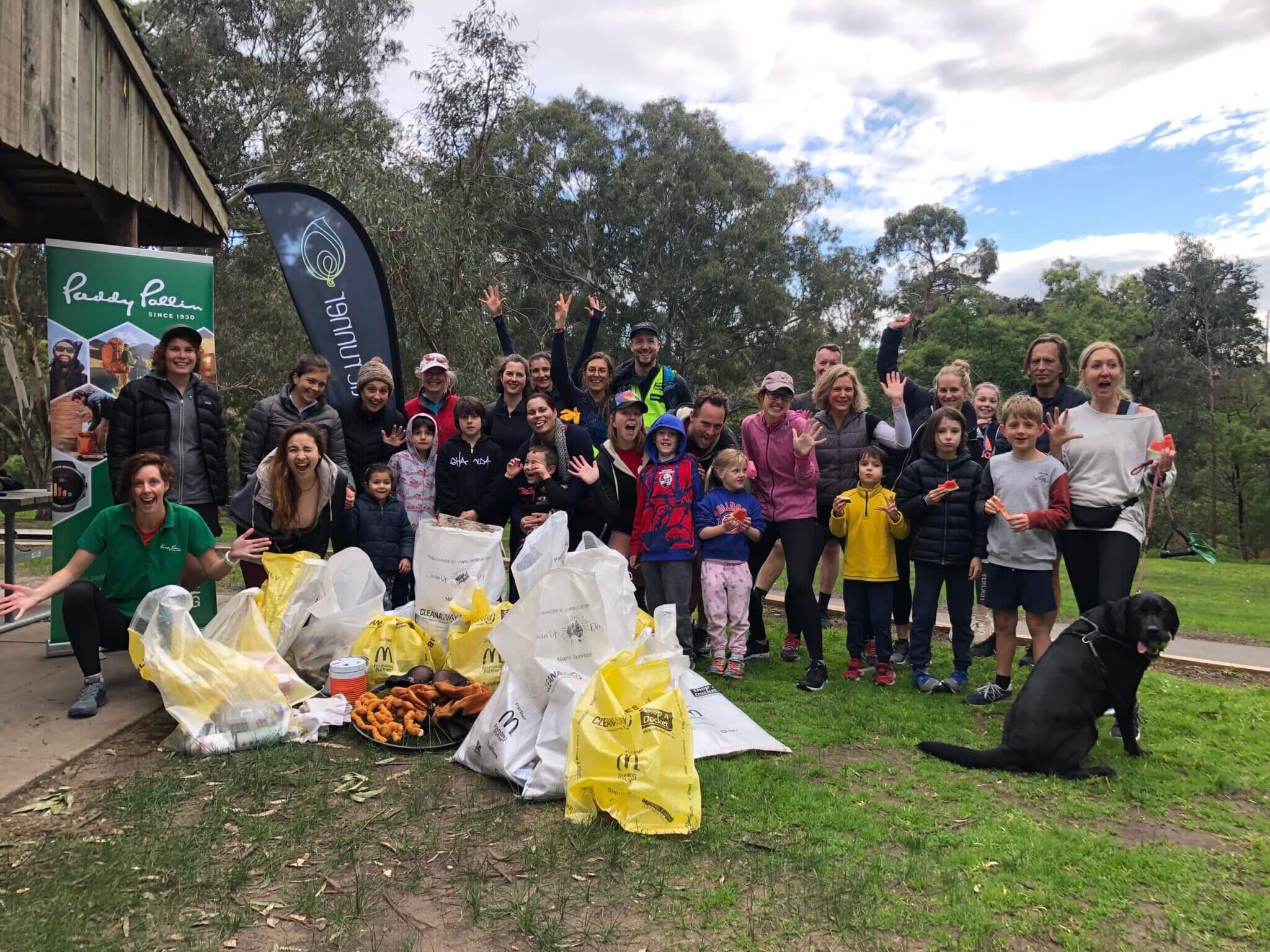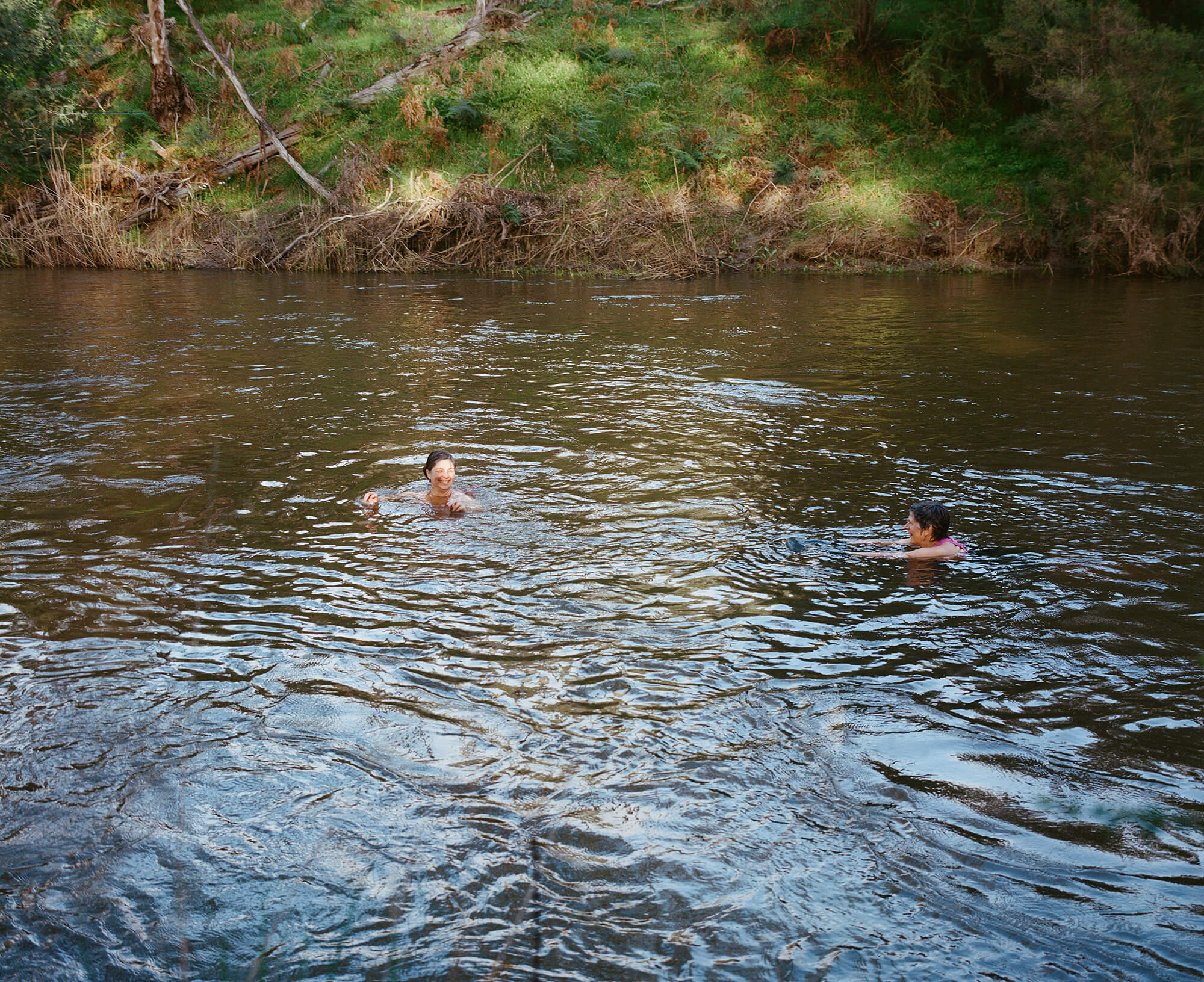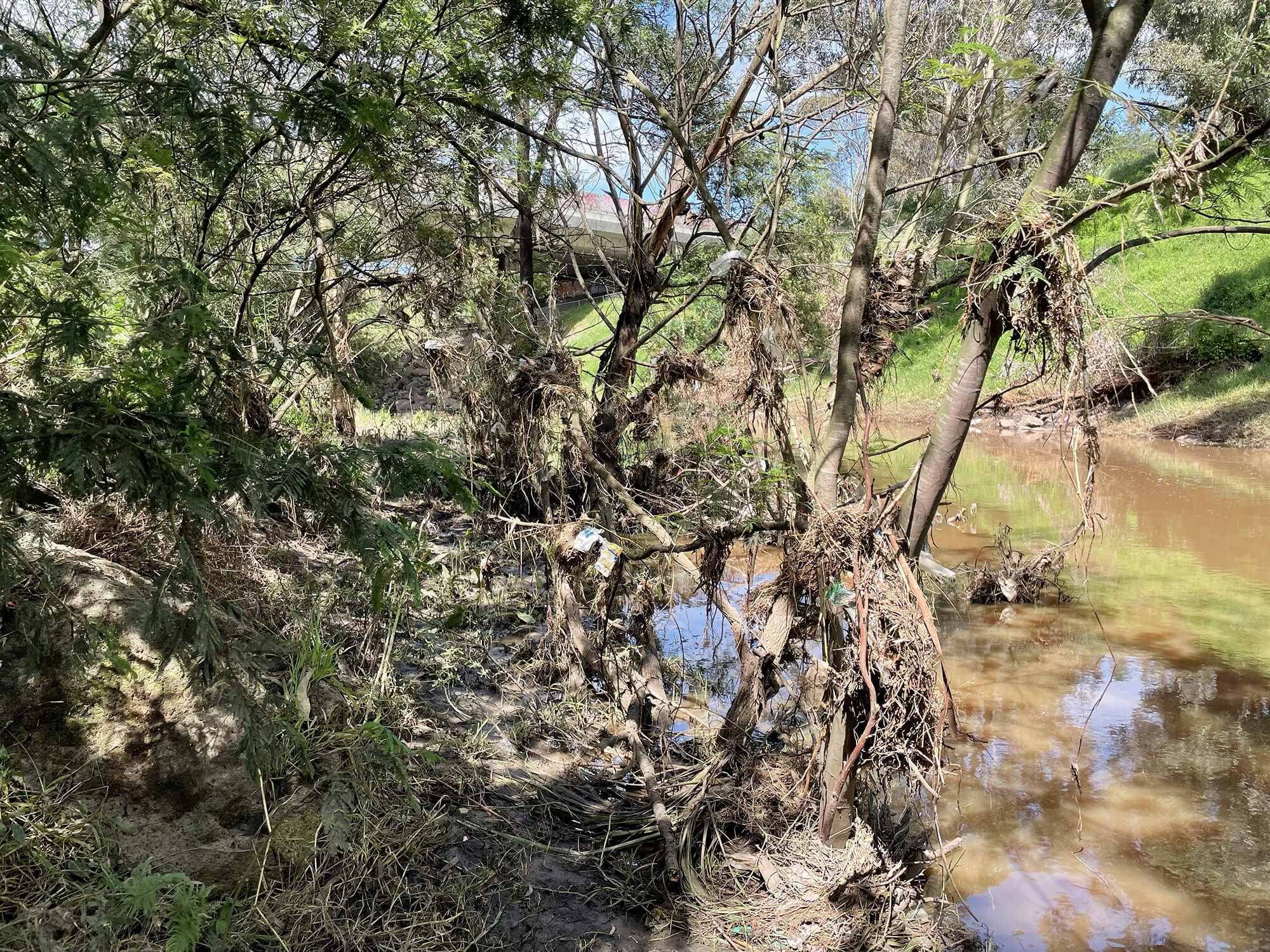




, By Carolyn
The first time I meet Karin Traeger, CEO of the Yarra Riverkeeper Association, on unceded Wurundjeri Woi Wurrung Country, she’s less than a fortnight away from beginning her epic, six-day run from the Birrarung’s source to its mouth.
–
 Karin at Pound Bend, Warrandyte, on day five of the run. Image: Christine McFetridge.
Karin at Pound Bend, Warrandyte, on day five of the run. Image: Christine McFetridge.
Sitting outside at Cam’s Kiosk at the Abbotsford Convent, a dog barking nearby for its owner inside the café, we (Karin, Carolyn Tate and myself) gather around hot mugs of chai to discuss Karin’s work and her plans for the run.
Listening to Karin share her story, it strikes me that grief and love are inextricably connected. Grief is because love is. This is evident in the conditions many of us have lived through recently; the impacts and realities of global heating and the ongoing Covid-19 pandemic.
For Karin, the relationship between grief and love has been a motivating force.
After training as a wildlife vet, Chilean-born Karin booked a one-way ticket to Cairns, where, as a divemaster, she witnessed one of the biggest coral reef bleaching events to occur to date.
She says, ‘The concept of climate change was super new to me then. It wasn’t widely discussed. When I saw the whole reef go white, I was like, “What the hell is happening here? And why is it happening?” So, I got involved with a group of local divers and we began surveying and taking photos of the coral every week to report back to an organisation that was collecting data.’
‘It was tough, but I found my purpose. I knew climate change was something I had to work on.’
Karin moved to Melbourne in 2016 and completed a Master of Environment degree. While she was studying, she trained for her first 100 km run, running alongside the Birrarung most days. Spending so much time by the river, Karin was troubled by the amount of rubbish along its banks. So, she started picking it up.
‘I was so upset. I asked a group of friends to help me, and we went for a run to collect rubbish around Studley Park. There were about 15 of us and we spent three hours cleaning up. We were shocked to find so much litter,’ she said.
Karin then founded The Plastic Runner, a grassroots community of ploggers—people who collect rubbish while jogging. Since it began, The Plastic Runner has brought together 500 volunteers at informal clean-up events, collecting around 1,500 kg of litter.
–
 A Plastic Runner event in July 2019. Image: The Plastic Runner blog.
A Plastic Runner event in July 2019. Image: The Plastic Runner blog.
Many plogging and running events later, Karin planned a 281km run from the Birrarung’s source to its mouth as a way of campaigning to raise awareness around water scarcity and acknowledge the significance of the river to Melbourne. ‘We are running out of water,’ Karin tells us, pun intended.
‘Globally, we’re in a water crisis. That’s a reality,’ Karin continues. ‘70% of Melbourne’s drinking water comes from the Birrarung. And with climate change, population growth and urban development, water consumption is going to be a big issue.’
‘I’d like more people to acknowledge the river, to be more thoughtful about their water use and understand that the water coming out of our taps comes from a live waterway,’ she says.
Pound Bend: day five of the run
Weeks later, on day five of Karin’s run, Carolyn and I decided to check in on how she was going.
It’s an early start. I set my alarm for 4:45 am to give me enough time to get from the city to Clifton Hill, where I meet Carolyn and Yarra Yabbies friends Loretta Bellato and Carrie Thomas to carpool to Pound Bend, Warrandyte.
Charlotte Sterrett, the Yarra Riverkeeper, is hosting a breakfast for Karin, before she continues on to her next stop at the Fairfield Boathouse. We arrive a little early and some of the group swim.
–
 Carrie and Donna swimming at Warrandyte. Image: Christine McFetridge.
Carrie and Donna swimming at Warrandyte. Image: Christine McFetridge.
When Karin meets us, she’s relaxed. I’m surprised by this. I’d imagined she’d look exhausted after running nearly 200 km—clearly, a projection based on my current lack of running fitness.
The previous Sunday, World Rivers Day, Karin began her run from the Birrarung’s source, near Cambarville; a secure water catchment area, surrounded by alpine ash and myrtle beech forest. This section of the river is inaccessible to the public.
From here, Karin ran approximately 70 km around the catchment to Reefton. During the following days, she ran from Reefton to Warburton; up Mount Donna Buang to Healesville; Healesville to Warrandyte; Warrandyte to the Fairfield Boathouse; and, finally, from the boathouse to Westgate Park.
After crossing the finish line, Karin had run 281 km over the six days of her trip—41 km more than the length of the Birrarung itself.
The Abbotsford Convent: post-run
Due to meet Karin at Cam’s Kiosk for a second time, Carolyn and I walk around the Merri Merri from Clifton Hill to its confluence with the Birrarung, following the path to Dights Falls.
The Birrarung is a torrent; the path between Dights Falls and the Convent is flooded and we take a detour through Abbotsford to get there. For the duration of the walk along the rivers, rubbish is tangled in trees along the riverbanks, revealing their highest points over the past few days.
–
 Rubbish along the Merri Merri. Image: Christine McFetridge.
Rubbish along the Merri Merri. Image: Christine McFetridge.
This, naturally, is where our conversation begins, however, in the interest of this article’s scope, it is one that will remain between the three of us for now.
‘As you ran, what did you observe along the river?’ I ask.
‘In comparison to waterways overseas, it’s not really a bad river—my perception was that it looked good. The upper Yarra seemed pretty clean. But it’s worth pointing out that the pollution is hard to see. There’s litter, of course, but there are also other chemicals that you can’t see with your bare eyes. Someone wouldn’t necessarily know how unhealthy it is in terms of biodiversity loss and pollution without the data I’m familiar with,’ Karin says.
‘And when we [Karin and her support crew] got to the city it was also confronting to see all the cement. We couldn’t believe that three or four days ago we were under this amazing forest canopy, and then now we were under a bridge in Docklands. It was a huge contrast.’
‘It was also interesting that we saw the most wildlife between Fairfield and Burnley, but we quickly realised the reason for this is that stretch is a haven for them. There are more animals concentrated in that area than in the bush.’
Karin continues by explaining that she didn’t want to approach the run with too many expectations. ‘I came with a really open mind that the run might create some exposure in terms of telling a different story. Or that I might change one person’s perspective and that’s enough. But I didn’t want to put myself under a lot of pressure by doing the run. Whatever comes, it comes,’ she said.
Finally, Carolyn asks Karin what her hopes and dreams are for the river. ‘My hopes and dreams are that as a collective, we can change the relationship we have with the river. I hope for a river that has less rubbish going down it. And that people stop calling it ugly and gross,’ she said.
Although she doesn’t rule out running the length of the Birrarung again, Karin does think she’d like to do it differently. Faster, perhaps. Watch this space.
Love your river, support your Riverkeeper by becoming a member or with a one-off or monthly donation.
Story by Christine McFetridge